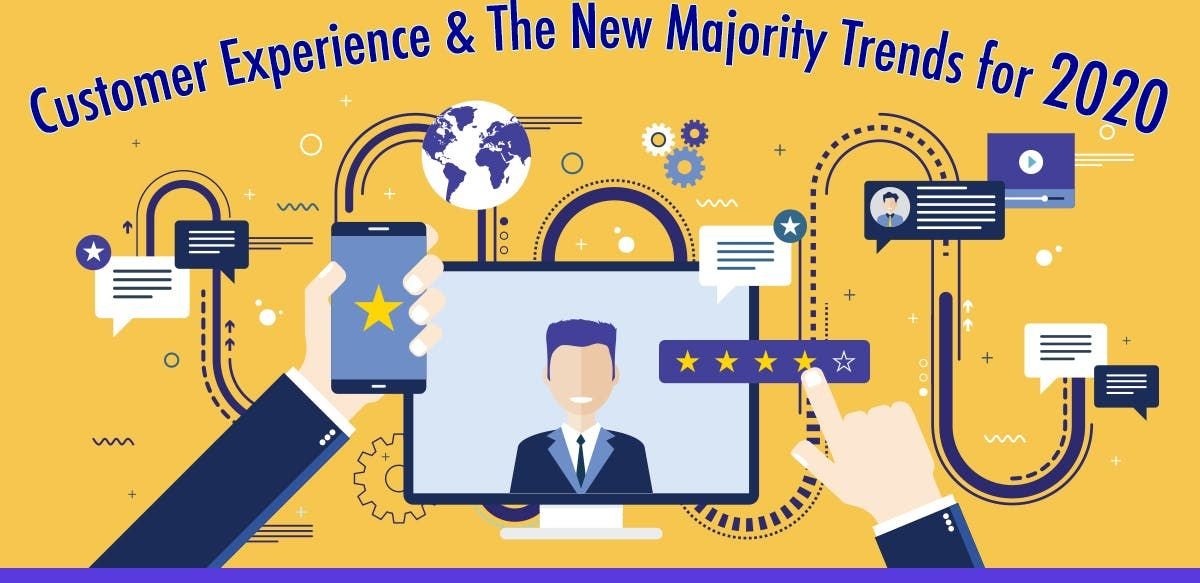The Future of CX: Five Customer Experience Trends for 2020 and Beyond

What Does the Future of CX Look Like?
If you know how critical Customer Experience is to the happiness of your customers and your team, you’re probably already trying to anticipate the next big trends in CX.
Things That Won’t Change Anytime Soon:
1. Customer Experience Still Reigns Supreme
More customers are stating that customer experience is a big part of how they make purchasing decisions. This means more of us are demanding better treatment and are willing to pay for it.
According to a large study by PWC, 73% of us say the customer experience is an important factor.
68% of business-to-business marketers agree that delivering a consistent, high-quality customer experience is very important in today’s marketplace.
Despite this, only 49% of Indian consumers say they’re getting a good Customer Experience from companies.
These numbers will keep going up, meaning that if you aren’t on board the CX train by now, you are already behind your competition.
But don’t fret — Instead, think of closing the CX gap as a huge opportunity. If your organization can address and close the gap, you’ll have a massive advantage in the future.
2. Employee Experience Will Remain One of the Top Influences on Customer Experience
There is no doubt the way employees feel influences how they treat customers.
But this isn’t just touchy-feely stuff. Engaged employees are in demand, and frankly getting harder to keep.
Investing in employees can pay off in big ways, like how Google gives employees 20% of their time to dedicate to their own projects. These independent, employee-driven ideas have created products like Google Maps and Gmail!
So it’s not terribly surprising to learn that the organizations who earned “good” or “very good” employee engagement ratings in the State of CX Management 2018 report by the Temkin Group (now part of the XM Institute) are also much more likely to be ranked as CX Leaders.
In fact, the percentage of CX Leaders who earned “good” or “very good” employee engagement ratings is more than 5-times larger than the percentage of CX Laggards.
Your employees matter more than most pieces of the customer experience puzzle. Don’t expect this to change in 2020 or the future beyond it.
So… What Changes Will Come to CX in 2020?
1. Customer Experience Will Become Part of the Business Operations in More Organizations… But it Will Continue to be an Unpredictable Journey.
More organizations are understanding the importance of customer experience, but they are still struggling with what to do about it.
Some are assigning CX as an additional responsibility to leaders like Chief Marketing Officers or Retail Operations leaders. Some are just asking everyone in the organization to “own” customer experience.
We need to mature past these ways to really start operationalizing CX in our organizations.
This means creating a dynamic loop of gathering customer feedback, assigning real responsibilities and treating CX like we treat sales, marketing or technology.
It’s not an extra part of doing business, it’s simply a part of doing business well.
More organizations will move to this phase in the coming years, but we still have a long way to go!
2. Agile principles will be brought to CX Innovation
As we (hopefully) move into an era when we’re responding to customer feedback and allowing for more innovation around experience design, we’ll need to act a lot faster than we are today. Organizations that prioritize quick improvements using agile principles will move to the head of the pack.
While agile is typically used among development teams, these same principles to harness change on behalf of customers can be used to innovate around CX.
It’s not just about the technology, it’s about innovation for things like in-store experience and better customer communications.
3. Technology WILL replace some roles in customer service and other departments. New roles will be created.
It’s true that the robots are coming for (some) of our jobs.
Automation, artificial intelligence (AI) and machine learning will drive real, lasting changes to the contact center structure and overall org charts of many brands. Already, chatbots and other tools are serving customers in big and small ways.
The latest prediction is a 136% increase in the number of organizations that use AI chatbots from 2019 to 2020!
While this can sound frightening, the role of these technologies will actually help customer service agents and others to provide better experiences for customers.
When leveraged well, this means human agents will have customer histories and relevant data served at the appropriate time. The agent can then provide more personalized, relevant experiences in a faster, more convenient way to customers.
It’s critical to provide a seamless transfer between human agent and bot as we learn just what this type of technology can do best. Now we need a different type of role for some of these agents. We need humans to train and supervise the automated experiences these bots are creating.
We can’t think we’ll simply “flip the switch” and replace our human agent force. Humans are still required to connect with customers when they need us the most. Humans are also the only way these tools will be developed and designed in ways that truly put the customer first.
4. Customers will not tolerate outdated technology, processes or communications.
Customers understand so much more than they ever did.
Because we all have access to so much more information now, brands can no longer hide behind press releases or advertising.
As customers, we want brands to respond not just to our needs, but the needs of the world around us. Outdated technology is a signal to customers that the overall experience might not be a priority. Watching employees struggle with processes that don’t make sense is a point of frustration for customers.
Communications with customers also have to not only be seamless, but updated in their language and tone.
Customers don’t want to interact with formal, stuffy brands using industry-specific terms and acronyms. They want to be in conversation with them.
This means reducing the jargon and replying as a human does. It also means reviewing your communications for outdated terms around our shared humanity, with terms referring to gender, race, and ability given particular care.
5. Soft skills will stop being seen as a nice to have and become the important “Empathy Toolkit” we need in CX.
Let’s make 2020 the year we kill the term “soft skills” in business. This vague description of ideas like getting along with others and listening doesn’t serve us or our customers.
These soft skills – listening well, responding with empathy and understanding, proactively reading the emotional state of a person or situation – are absolutely critical to great customer experiences.
And let’s not forget this applies inside the organization, too. Engaged employees not only serve their customers with this respect and compassion but also serve their colleagues and partners this way, too.
Using the term “soft skills” make them sound secondary and unnecessary. CX Leaders in the future will prioritize them and give them the respect they deserve to hire, train and empower employees.





Leave a Comment